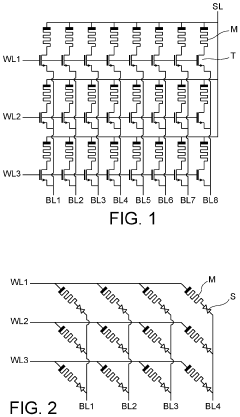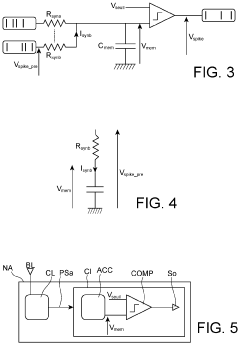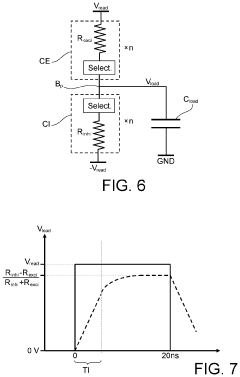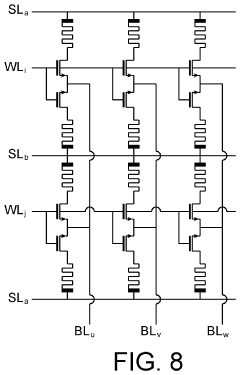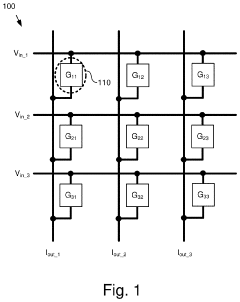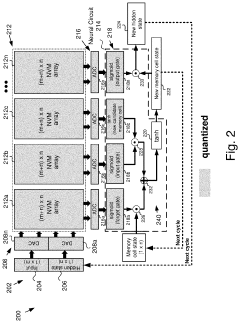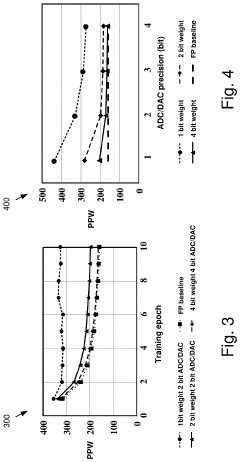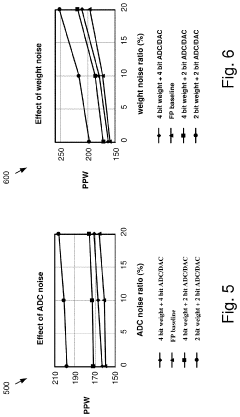Why Neuromorphic Chips Are Vital for Defense Electronics Innovation
OCT 9, 202510 MIN READ
Generate Your Research Report Instantly with AI Agent
Patsnap Eureka helps you evaluate technical feasibility & market potential.
Neuromorphic Computing Evolution and Defense Objectives
Neuromorphic computing represents a paradigm shift in computational architecture, drawing inspiration from the human brain's neural networks to create more efficient, adaptive, and powerful computing systems. The evolution of this technology has progressed from theoretical concepts in the 1980s to practical implementations in recent years, with significant advancements in hardware design, algorithm development, and system integration.
The trajectory of neuromorphic computing has been marked by several key milestones. Early research focused on understanding neural network principles and developing basic electronic analogs. This was followed by the creation of specialized hardware that could mimic neural functions, such as IBM's TrueNorth and Intel's Loihi chips. Recent developments have concentrated on improving energy efficiency, reducing form factors, and enhancing computational capabilities to handle complex, real-time data processing tasks.
In the defense sector, neuromorphic computing addresses critical technological needs that conventional computing architectures struggle to meet. Traditional von Neumann architectures face limitations in processing speed, power consumption, and adaptability—all crucial factors in modern defense systems. Neuromorphic chips offer solutions to these challenges through parallel processing, reduced power requirements, and the ability to learn and adapt to new situations without explicit programming.
The primary objectives for neuromorphic computing in defense applications include enhancing autonomous systems' decision-making capabilities, improving real-time signal processing for radar and communications, enabling advanced pattern recognition for threat detection, and supporting edge computing in resource-constrained environments. These objectives align with broader defense modernization efforts focused on maintaining technological superiority in increasingly complex operational environments.
Current trends indicate a convergence of neuromorphic computing with other emerging technologies, including quantum computing, advanced materials science, and artificial intelligence. This integration promises to create hybrid systems that leverage the strengths of each approach while mitigating individual limitations. For defense applications, this could translate to systems capable of unprecedented levels of autonomous operation, situational awareness, and adaptive response.
The technical goals for neuromorphic computing in defense electronics include achieving orders-of-magnitude improvements in energy efficiency, developing radiation-hardened implementations for space and nuclear environments, creating fault-tolerant architectures for mission-critical applications, and establishing standardized interfaces for integration with existing defense systems. Additionally, there is significant interest in neuromorphic solutions that can operate effectively in denied or degraded information environments where traditional computing systems might fail.
As global competition in advanced defense technologies intensifies, neuromorphic computing represents a critical area for innovation and investment. Nations and defense organizations that successfully harness this technology will gain significant advantages in military capabilities, intelligence processing, and operational resilience against emerging threats.
The trajectory of neuromorphic computing has been marked by several key milestones. Early research focused on understanding neural network principles and developing basic electronic analogs. This was followed by the creation of specialized hardware that could mimic neural functions, such as IBM's TrueNorth and Intel's Loihi chips. Recent developments have concentrated on improving energy efficiency, reducing form factors, and enhancing computational capabilities to handle complex, real-time data processing tasks.
In the defense sector, neuromorphic computing addresses critical technological needs that conventional computing architectures struggle to meet. Traditional von Neumann architectures face limitations in processing speed, power consumption, and adaptability—all crucial factors in modern defense systems. Neuromorphic chips offer solutions to these challenges through parallel processing, reduced power requirements, and the ability to learn and adapt to new situations without explicit programming.
The primary objectives for neuromorphic computing in defense applications include enhancing autonomous systems' decision-making capabilities, improving real-time signal processing for radar and communications, enabling advanced pattern recognition for threat detection, and supporting edge computing in resource-constrained environments. These objectives align with broader defense modernization efforts focused on maintaining technological superiority in increasingly complex operational environments.
Current trends indicate a convergence of neuromorphic computing with other emerging technologies, including quantum computing, advanced materials science, and artificial intelligence. This integration promises to create hybrid systems that leverage the strengths of each approach while mitigating individual limitations. For defense applications, this could translate to systems capable of unprecedented levels of autonomous operation, situational awareness, and adaptive response.
The technical goals for neuromorphic computing in defense electronics include achieving orders-of-magnitude improvements in energy efficiency, developing radiation-hardened implementations for space and nuclear environments, creating fault-tolerant architectures for mission-critical applications, and establishing standardized interfaces for integration with existing defense systems. Additionally, there is significant interest in neuromorphic solutions that can operate effectively in denied or degraded information environments where traditional computing systems might fail.
As global competition in advanced defense technologies intensifies, neuromorphic computing represents a critical area for innovation and investment. Nations and defense organizations that successfully harness this technology will gain significant advantages in military capabilities, intelligence processing, and operational resilience against emerging threats.
Military Applications and Market Demand Analysis
The defense sector represents one of the most promising markets for neuromorphic computing technology, with demand driven by increasingly complex battlefield environments and the need for autonomous decision-making capabilities. Current market analysis indicates that defense electronics innovation is rapidly shifting toward systems that can process massive amounts of sensor data in real-time while operating under strict power constraints – precisely the conditions where neuromorphic architectures excel.
Military applications for neuromorphic chips span several critical domains. Intelligence, surveillance, and reconnaissance (ISR) systems benefit significantly from these chips' ability to process visual and audio data with exceptional efficiency. Target recognition systems deployed in unmanned aerial vehicles (UAVs) and other platforms require rapid pattern recognition capabilities that can operate independently of cloud connectivity, making neuromorphic solutions particularly valuable in contested electromagnetic environments.
Electronic warfare represents another high-demand application area, where neuromorphic systems can rapidly adapt to evolving signal environments and detect anomalous patterns that might indicate jamming or spoofing attempts. The chips' inherent resilience to radiation effects also makes them suitable for space-based defense systems where traditional computing architectures face significant challenges.
Market forecasts for neuromorphic computing in defense applications project substantial growth over the next decade. This expansion is driven by increasing investments in autonomous weapons systems, advanced radar and signal processing capabilities, and AI-enhanced battlefield management systems. Defense departments worldwide are allocating significant portions of their research budgets to neuromorphic computing, recognizing its potential to provide decisive technological advantages.
The demand for low-power, high-performance computing at the tactical edge is particularly acute. Forward-deployed units require systems that can operate for extended periods without recharging while maintaining sophisticated computational capabilities. Neuromorphic chips address this need directly, offering power efficiencies orders of magnitude better than conventional computing architectures when handling sensor fusion and pattern recognition tasks.
Several defense contractors have established dedicated neuromorphic research divisions, indicating strong industry confidence in the technology's military applications. These investments are complemented by government-funded research programs specifically targeting the integration of neuromorphic computing into next-generation defense systems. The convergence of military requirements with neuromorphic capabilities suggests a robust and growing market that will drive significant innovation in this field over the coming years.
Military applications for neuromorphic chips span several critical domains. Intelligence, surveillance, and reconnaissance (ISR) systems benefit significantly from these chips' ability to process visual and audio data with exceptional efficiency. Target recognition systems deployed in unmanned aerial vehicles (UAVs) and other platforms require rapid pattern recognition capabilities that can operate independently of cloud connectivity, making neuromorphic solutions particularly valuable in contested electromagnetic environments.
Electronic warfare represents another high-demand application area, where neuromorphic systems can rapidly adapt to evolving signal environments and detect anomalous patterns that might indicate jamming or spoofing attempts. The chips' inherent resilience to radiation effects also makes them suitable for space-based defense systems where traditional computing architectures face significant challenges.
Market forecasts for neuromorphic computing in defense applications project substantial growth over the next decade. This expansion is driven by increasing investments in autonomous weapons systems, advanced radar and signal processing capabilities, and AI-enhanced battlefield management systems. Defense departments worldwide are allocating significant portions of their research budgets to neuromorphic computing, recognizing its potential to provide decisive technological advantages.
The demand for low-power, high-performance computing at the tactical edge is particularly acute. Forward-deployed units require systems that can operate for extended periods without recharging while maintaining sophisticated computational capabilities. Neuromorphic chips address this need directly, offering power efficiencies orders of magnitude better than conventional computing architectures when handling sensor fusion and pattern recognition tasks.
Several defense contractors have established dedicated neuromorphic research divisions, indicating strong industry confidence in the technology's military applications. These investments are complemented by government-funded research programs specifically targeting the integration of neuromorphic computing into next-generation defense systems. The convergence of military requirements with neuromorphic capabilities suggests a robust and growing market that will drive significant innovation in this field over the coming years.
Current Neuromorphic Technology Landscape and Barriers
The neuromorphic computing landscape is currently experiencing significant growth, with major technology companies and research institutions investing heavily in this field. IBM's TrueNorth and Intel's Loihi represent the current state-of-the-art commercial neuromorphic chips, demonstrating the industry's commitment to advancing this technology. TrueNorth features one million digital neurons and 256 million synapses, while Loihi 2 showcases improved performance with up to one million neurons and enhanced learning capabilities. These developments highlight the rapid evolution of neuromorphic technology in recent years.
Despite these advancements, neuromorphic computing faces substantial technical challenges. Power efficiency, although improved compared to traditional computing architectures, still falls short of the human brain's remarkable energy efficiency. Current neuromorphic systems consume orders of magnitude more power per operation than biological neural systems, limiting their deployment in power-constrained defense applications such as autonomous drones or field-deployable intelligence systems.
Scalability presents another significant barrier. While existing chips contain millions of neurons, the human brain possesses approximately 86 billion neurons with trillions of synaptic connections. Achieving comparable scale while maintaining energy efficiency remains a formidable challenge. Additionally, the manufacturing processes for these specialized chips are complex and expensive, hindering widespread adoption and implementation in defense systems.
The hardware-software integration challenge cannot be overlooked. Programming paradigms for neuromorphic systems differ fundamentally from traditional computing approaches. Defense applications require robust, reliable software frameworks that can effectively harness the unique capabilities of neuromorphic hardware while meeting stringent military specifications. Currently, the development environment for neuromorphic computing lacks standardization and mature toolchains, creating barriers for defense contractors and military research labs.
Geographically, neuromorphic research centers are concentrated primarily in North America, Europe, and East Asia. The United States leads with significant investments from DARPA's SyNAPSE program and corporate research labs. Europe contributes through the Human Brain Project and various university initiatives, while China has recently increased funding for neuromorphic research through its Brain Science Project. This distribution creates potential national security implications regarding technology access and supply chain resilience for defense applications.
Reliability and robustness in harsh environments represent critical concerns for defense electronics. Current neuromorphic systems have not been thoroughly tested under extreme conditions such as radiation exposure, temperature fluctuations, and electromagnetic interference—all common challenges in military operations. Addressing these environmental resilience issues is essential before widespread deployment in mission-critical defense systems can occur.
Despite these advancements, neuromorphic computing faces substantial technical challenges. Power efficiency, although improved compared to traditional computing architectures, still falls short of the human brain's remarkable energy efficiency. Current neuromorphic systems consume orders of magnitude more power per operation than biological neural systems, limiting their deployment in power-constrained defense applications such as autonomous drones or field-deployable intelligence systems.
Scalability presents another significant barrier. While existing chips contain millions of neurons, the human brain possesses approximately 86 billion neurons with trillions of synaptic connections. Achieving comparable scale while maintaining energy efficiency remains a formidable challenge. Additionally, the manufacturing processes for these specialized chips are complex and expensive, hindering widespread adoption and implementation in defense systems.
The hardware-software integration challenge cannot be overlooked. Programming paradigms for neuromorphic systems differ fundamentally from traditional computing approaches. Defense applications require robust, reliable software frameworks that can effectively harness the unique capabilities of neuromorphic hardware while meeting stringent military specifications. Currently, the development environment for neuromorphic computing lacks standardization and mature toolchains, creating barriers for defense contractors and military research labs.
Geographically, neuromorphic research centers are concentrated primarily in North America, Europe, and East Asia. The United States leads with significant investments from DARPA's SyNAPSE program and corporate research labs. Europe contributes through the Human Brain Project and various university initiatives, while China has recently increased funding for neuromorphic research through its Brain Science Project. This distribution creates potential national security implications regarding technology access and supply chain resilience for defense applications.
Reliability and robustness in harsh environments represent critical concerns for defense electronics. Current neuromorphic systems have not been thoroughly tested under extreme conditions such as radiation exposure, temperature fluctuations, and electromagnetic interference—all common challenges in military operations. Addressing these environmental resilience issues is essential before widespread deployment in mission-critical defense systems can occur.
State-of-the-Art Neuromorphic Solutions for Defense
01 Neuromorphic architecture design
Neuromorphic chips are designed to mimic the structure and functionality of the human brain, with architectures that incorporate neural networks, synaptic connections, and parallel processing capabilities. These designs enable efficient processing of complex data patterns and learning capabilities similar to biological neural systems. The architecture typically includes interconnected artificial neurons that can process information in parallel, making them suitable for AI applications requiring pattern recognition and adaptive learning.- Neuromorphic architecture design and implementation: Neuromorphic chips are designed to mimic the structure and functionality of the human brain, using specialized hardware architectures that enable efficient processing of neural network operations. These designs incorporate parallel processing elements, synaptic connections, and memory structures that closely resemble biological neural systems. The architecture typically includes arrays of artificial neurons and synapses that can process information in a distributed manner, allowing for high computational efficiency while consuming significantly less power than traditional computing architectures.
- Memristor-based neuromorphic computing: Memristors are used as key components in neuromorphic chips to emulate synaptic behavior. These devices can store and process information simultaneously, similar to biological synapses, by changing their resistance based on the history of current flow. Memristor-based neuromorphic systems offer advantages in terms of energy efficiency, density, and the ability to implement learning algorithms directly in hardware. These systems can perform both memory and computing functions in the same physical location, reducing the energy costs associated with data movement between separate memory and processing units.
- Spiking neural networks implementation: Spiking neural networks (SNNs) represent a biologically plausible approach to neural computation in neuromorphic chips. Unlike traditional artificial neural networks, SNNs process information through discrete spikes or events, similar to biological neurons. This event-driven processing allows for significant power savings as computation occurs only when necessary. Neuromorphic chips implementing SNNs can efficiently handle temporal data and perform real-time processing tasks while maintaining low power consumption, making them suitable for edge computing applications and mobile devices.
- On-chip learning and adaptation mechanisms: Neuromorphic chips incorporate on-chip learning capabilities that allow them to adapt to new data without requiring external training systems. These chips implement various learning algorithms such as spike-timing-dependent plasticity (STDP), reinforcement learning, and unsupervised learning directly in hardware. The ability to learn and adapt in real-time enables these chips to continuously improve their performance based on incoming data, making them particularly valuable for applications in dynamic environments where conditions may change unpredictably.
- Application-specific neuromorphic systems: Neuromorphic chips are being developed for specific applications such as computer vision, speech recognition, sensor processing, and autonomous systems. These application-specific designs optimize the neuromorphic architecture for particular tasks, balancing performance, power consumption, and area constraints. By tailoring the hardware to specific computational patterns required by these applications, neuromorphic chips can achieve orders of magnitude improvements in energy efficiency compared to conventional computing approaches while maintaining high performance for their target applications.
02 Memristor-based neuromorphic computing
Memristors are used as key components in neuromorphic chips to simulate synaptic behavior. These devices can change their resistance based on the history of current flow, similar to how biological synapses change their strength. Memristor-based neuromorphic systems offer advantages in power efficiency, density, and the ability to perform both memory and computing functions in the same device. This approach enables more efficient implementation of neural networks in hardware with significantly reduced power consumption compared to traditional computing architectures.Expand Specific Solutions03 Spiking neural networks implementation
Spiking neural networks (SNNs) represent a biologically inspired approach to neuromorphic computing where information is transmitted through discrete spikes rather than continuous signals. These implementations more closely resemble the communication method of biological neurons and offer potential advantages in energy efficiency for certain applications. SNN-based neuromorphic chips can process temporal information more effectively and are particularly suitable for real-time processing of sensory data such as vision and audio signals.Expand Specific Solutions04 On-chip learning and adaptation mechanisms
Advanced neuromorphic chips incorporate on-chip learning capabilities that allow them to adapt to new information without requiring external training. These systems implement various learning algorithms such as spike-timing-dependent plasticity (STDP) directly in hardware, enabling continuous learning from environmental inputs. This feature makes neuromorphic chips particularly valuable for edge computing applications where adaptability to changing conditions is required without constant communication with centralized servers.Expand Specific Solutions05 Integration with conventional computing systems
Neuromorphic chips are designed to interface with traditional computing architectures, creating hybrid systems that leverage the strengths of both approaches. These integration methods include specialized hardware interfaces, software frameworks, and data conversion mechanisms that allow neuromorphic processors to complement conventional CPUs and GPUs. The resulting hybrid systems can efficiently handle both precise mathematical computations and pattern recognition tasks, making them suitable for complex applications in robotics, autonomous vehicles, and advanced AI systems.Expand Specific Solutions
Leading Defense Contractors and Research Institutions
Neuromorphic chip technology for defense electronics is currently in an early growth phase, characterized by significant R&D investments but limited commercial deployment. The market is projected to expand rapidly, reaching approximately $3-5 billion by 2028, driven by increasing defense modernization initiatives. From a technical maturity perspective, the landscape shows varying development stages across key players. IBM leads with established neuromorphic architectures, while Syntiant and Polyn Technology offer specialized low-power solutions. Samsung, SK Hynix, and Western Digital are advancing memory-centric approaches. Academic institutions like Tsinghua University, KAIST, and Beihang University collaborate with military entities to develop defense-specific implementations. The US Air Force's involvement signals the strategic importance of this technology for next-generation defense systems requiring autonomous decision-making capabilities in contested environments.
International Business Machines Corp.
Technical Solution: IBM's TrueNorth neuromorphic chip architecture represents one of the most advanced implementations in the field, specifically designed to mimic the brain's neural structure. The chip contains one million programmable neurons and 256 million synapses, consuming only 70mW of power while delivering the equivalent of 46 billion synaptic operations per second per watt. For defense applications, IBM has demonstrated TrueNorth's capabilities in real-time object recognition, threat detection, and autonomous navigation systems. The architecture employs a non-von Neumann computing approach with distributed memory and parallel processing that enables rapid pattern recognition in complex environments. IBM has also developed SyNAPSE (Systems of Neuromorphic Adaptive Plastic Scalable Electronics) program in collaboration with DARPA, specifically targeting military applications requiring low-power, high-speed sensory processing and decision-making capabilities.
Strengths: Extremely low power consumption (70mW) makes it ideal for deployment in resource-constrained defense environments; Highly scalable architecture allows for system expansion to meet complex military requirements; Demonstrated resilience to noise and environmental variations critical for battlefield conditions. Weaknesses: Programming complexity requires specialized expertise; Integration challenges with existing defense electronic systems; Higher initial implementation costs compared to traditional computing solutions.
SYNTIANT CORP
Technical Solution: Syntiant has developed the Neural Decision Processor (NDP), a specialized neuromorphic chip architecture optimized for edge AI applications with particular relevance to defense electronics. Their NDP100 and NDP200 series chips deliver ultra-low-power neural network processing (operating at under 1mW) while enabling always-on voice and sensor processing capabilities critical for defense applications. Syntiant's technology employs a unique memory-centric computing approach that minimizes data movement, dramatically reducing power consumption while maintaining high computational throughput. For defense applications, Syntiant's chips enable advanced acoustic monitoring, threat detection, and secure communications in field conditions where power constraints are significant. The company has developed specialized training methodologies that allow their neuromorphic chips to be rapidly deployed with custom recognition capabilities for specific defense scenarios, including drone detection, weapon system identification, and encrypted communications processing.
Strengths: Extremely low power consumption (sub-milliwatt) enables deployment in battery-powered defense systems with extended field operation; Specialized for audio and sensor processing applications critical for battlefield awareness; Compact form factor allows integration into wearable military equipment and small unmanned systems. Weaknesses: More specialized functionality compared to general-purpose neuromorphic solutions; Limited computational capacity for complex multi-modal processing tasks; Relatively new technology with less field-proven reliability in combat conditions.
Critical Patents and Research in Defense Neuromorphic Computing
Artificial neuron for neuromorphic chip with resistive synapses
PatentActiveUS11630993B2
Innovation
- An artificial neuron design that includes a read circuit to impose a read voltage independent of the membrane voltage, providing an analogue value representative of the synaptic weight as duration, and a logic circuit to generate a pulse corresponding to this duration, allowing for decoupled reading and integration, thereby improving energy efficiency and reducing parasitic writing risks.
Hardware Accelerated Discretized Neural Network
PatentActiveUS20210334338A1
Innovation
- A quantized neural network architecture that converts digital input and hidden state signals into analog form, processes them using non-volatile memory weight arrays for vector matrix multiplication, and then converts back to digital, with bit-widths reduced to 4 bits or less, utilizing DACs and ADCs to maintain performance comparable to 32-bit implementations.
National Security Implications and Strategic Considerations
Neuromorphic computing represents a critical frontier for national defense capabilities, offering unprecedented advantages in battlefield intelligence, autonomous systems, and secure communications. The integration of these brain-inspired chips into defense electronics creates asymmetric advantages through enhanced signal processing capabilities that can operate effectively in contested electromagnetic environments where traditional computing systems may fail.
The strategic importance of neuromorphic technology extends beyond tactical applications to broader national security considerations. Nations leading in neuromorphic computing development gain significant technological sovereignty, reducing dependence on foreign semiconductor supply chains that have proven vulnerable to disruption. This technological independence becomes increasingly vital as global semiconductor competition intensifies between major powers.
Neuromorphic systems provide unique capabilities for advanced threat detection through their ability to process sensor data with human-like pattern recognition while consuming minimal power. This enables persistent surveillance systems that can operate at the tactical edge without frequent battery replacement or significant power infrastructure, addressing a critical vulnerability in current field deployments.
From a strategic perspective, neuromorphic computing represents a potential paradigm shift in military decision-making frameworks. These systems can process complex battlefield information in real-time, supporting commanders with adaptive intelligence that evolves based on changing conditions. This capability becomes particularly valuable in scenarios where communications with central command may be compromised or unavailable.
The race to develop and deploy neuromorphic technology has significant geopolitical implications. Nations that master this technology gain advantages in both offensive and defensive electronic warfare capabilities, potentially altering regional power balances. Defense planners increasingly view neuromorphic computing as a critical technology for maintaining strategic parity or advantage against near-peer competitors.
Ethical and governance considerations also emerge as neuromorphic systems approach human-like decision-making capabilities in defense applications. The development of appropriate command and control frameworks, along with clear ethical guidelines for autonomous systems powered by neuromorphic chips, represents an urgent policy requirement that parallels the technical development path.
Investment in neuromorphic defense applications also drives broader economic and innovation ecosystems, creating spillover benefits for civilian applications and strengthening national technological competitiveness. This dual-use characteristic makes neuromorphic computing a particularly valuable focus area for defense research and development portfolios seeking to maximize return on investment across both military and civilian domains.
The strategic importance of neuromorphic technology extends beyond tactical applications to broader national security considerations. Nations leading in neuromorphic computing development gain significant technological sovereignty, reducing dependence on foreign semiconductor supply chains that have proven vulnerable to disruption. This technological independence becomes increasingly vital as global semiconductor competition intensifies between major powers.
Neuromorphic systems provide unique capabilities for advanced threat detection through their ability to process sensor data with human-like pattern recognition while consuming minimal power. This enables persistent surveillance systems that can operate at the tactical edge without frequent battery replacement or significant power infrastructure, addressing a critical vulnerability in current field deployments.
From a strategic perspective, neuromorphic computing represents a potential paradigm shift in military decision-making frameworks. These systems can process complex battlefield information in real-time, supporting commanders with adaptive intelligence that evolves based on changing conditions. This capability becomes particularly valuable in scenarios where communications with central command may be compromised or unavailable.
The race to develop and deploy neuromorphic technology has significant geopolitical implications. Nations that master this technology gain advantages in both offensive and defensive electronic warfare capabilities, potentially altering regional power balances. Defense planners increasingly view neuromorphic computing as a critical technology for maintaining strategic parity or advantage against near-peer competitors.
Ethical and governance considerations also emerge as neuromorphic systems approach human-like decision-making capabilities in defense applications. The development of appropriate command and control frameworks, along with clear ethical guidelines for autonomous systems powered by neuromorphic chips, represents an urgent policy requirement that parallels the technical development path.
Investment in neuromorphic defense applications also drives broader economic and innovation ecosystems, creating spillover benefits for civilian applications and strengthening national technological competitiveness. This dual-use characteristic makes neuromorphic computing a particularly valuable focus area for defense research and development portfolios seeking to maximize return on investment across both military and civilian domains.
Energy Efficiency and Field Deployment Challenges
Energy efficiency represents one of the most critical challenges in defense electronics deployment, particularly in remote or hostile environments where power sources are limited. Neuromorphic chips offer a revolutionary solution to this challenge by mimicking the brain's neural architecture, which operates at remarkably low power levels compared to traditional computing systems. While conventional processors might consume watts or even kilowatts of power, neuromorphic systems can potentially operate in the milliwatt range while performing complex computational tasks.
This energy efficiency translates directly to extended operational capabilities in field deployments. Defense systems equipped with neuromorphic chips can maintain functionality for significantly longer periods without recharging or refueling, a crucial advantage in extended missions or isolated deployments. For instance, autonomous drones utilizing neuromorphic processing could potentially extend their surveillance missions from hours to days, dramatically enhancing intelligence gathering capabilities.
The reduced heat signature resulting from lower power consumption also provides tactical advantages in combat situations. Traditional high-performance computing systems generate substantial heat, making them detectable by thermal imaging technologies. Neuromorphic systems, with their significantly lower thermal output, offer enhanced stealth capabilities for sensitive electronic warfare equipment and surveillance systems.
Field deployment of defense electronics faces additional challenges beyond power consumption. Environmental factors such as extreme temperatures, moisture, dust, and vibration can compromise electronic performance. Neuromorphic architectures, with their distributed processing approach and potential for greater fault tolerance, demonstrate promising resilience against these environmental stressors. This inherent robustness makes them particularly suitable for deployment in harsh battlefield conditions.
Size and weight constraints represent another significant challenge for defense electronics. Military personnel already carry substantial equipment loads, and vehicle-based systems must balance computational capability against space limitations. Neuromorphic chips, with their efficient architecture, can deliver substantial computational power in smaller form factors, enabling more compact and lightweight defense systems without sacrificing performance.
The integration of neuromorphic computing into existing defense infrastructure presents its own set of challenges. Legacy systems and established protocols may require significant adaptation to fully leverage neuromorphic capabilities. Additionally, ensuring secure operation and protecting these advanced chips from adversarial tampering or exploitation necessitates new security frameworks specifically designed for neuromorphic architectures.
This energy efficiency translates directly to extended operational capabilities in field deployments. Defense systems equipped with neuromorphic chips can maintain functionality for significantly longer periods without recharging or refueling, a crucial advantage in extended missions or isolated deployments. For instance, autonomous drones utilizing neuromorphic processing could potentially extend their surveillance missions from hours to days, dramatically enhancing intelligence gathering capabilities.
The reduced heat signature resulting from lower power consumption also provides tactical advantages in combat situations. Traditional high-performance computing systems generate substantial heat, making them detectable by thermal imaging technologies. Neuromorphic systems, with their significantly lower thermal output, offer enhanced stealth capabilities for sensitive electronic warfare equipment and surveillance systems.
Field deployment of defense electronics faces additional challenges beyond power consumption. Environmental factors such as extreme temperatures, moisture, dust, and vibration can compromise electronic performance. Neuromorphic architectures, with their distributed processing approach and potential for greater fault tolerance, demonstrate promising resilience against these environmental stressors. This inherent robustness makes them particularly suitable for deployment in harsh battlefield conditions.
Size and weight constraints represent another significant challenge for defense electronics. Military personnel already carry substantial equipment loads, and vehicle-based systems must balance computational capability against space limitations. Neuromorphic chips, with their efficient architecture, can deliver substantial computational power in smaller form factors, enabling more compact and lightweight defense systems without sacrificing performance.
The integration of neuromorphic computing into existing defense infrastructure presents its own set of challenges. Legacy systems and established protocols may require significant adaptation to fully leverage neuromorphic capabilities. Additionally, ensuring secure operation and protecting these advanced chips from adversarial tampering or exploitation necessitates new security frameworks specifically designed for neuromorphic architectures.
Unlock deeper insights with Patsnap Eureka Quick Research — get a full tech report to explore trends and direct your research. Try now!
Generate Your Research Report Instantly with AI Agent
Supercharge your innovation with Patsnap Eureka AI Agent Platform!
